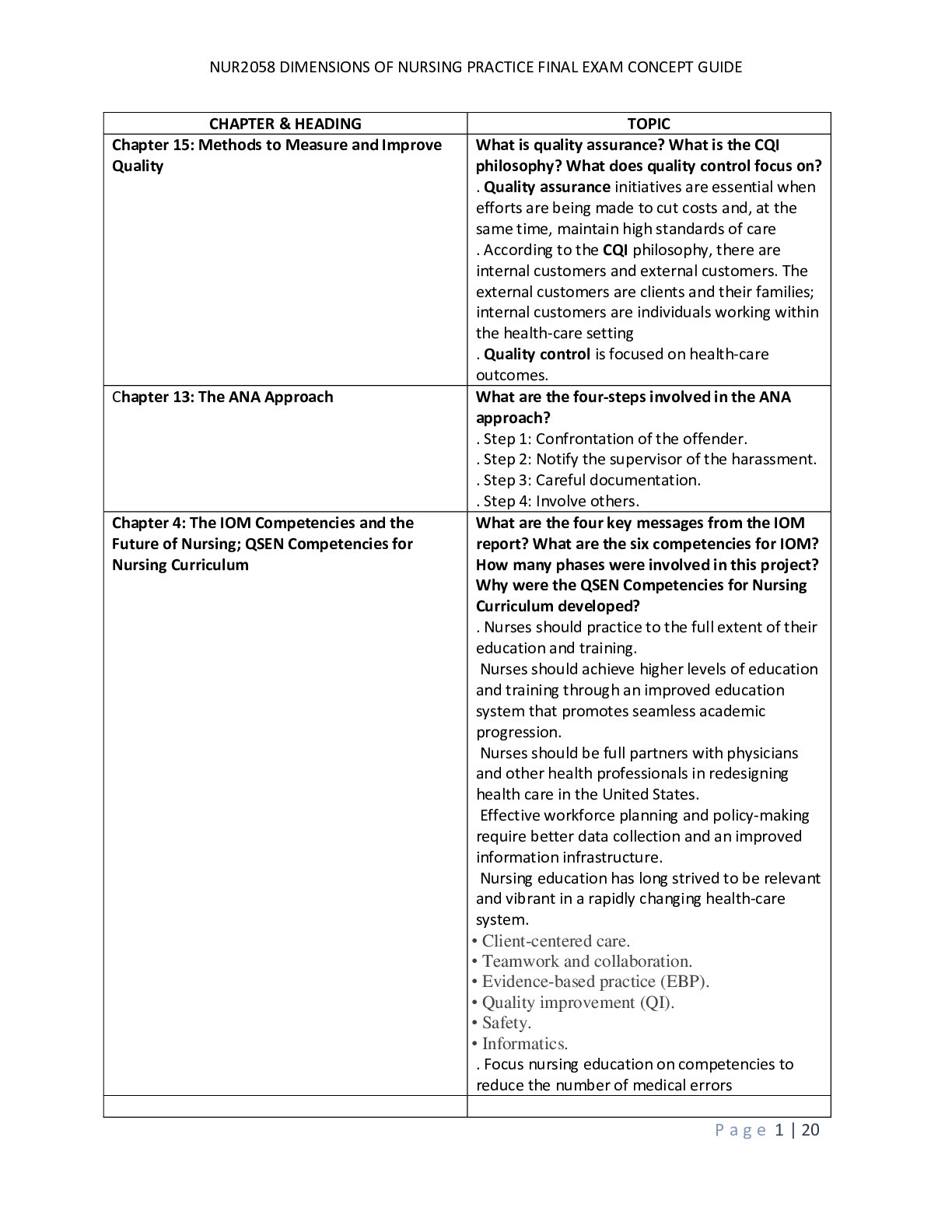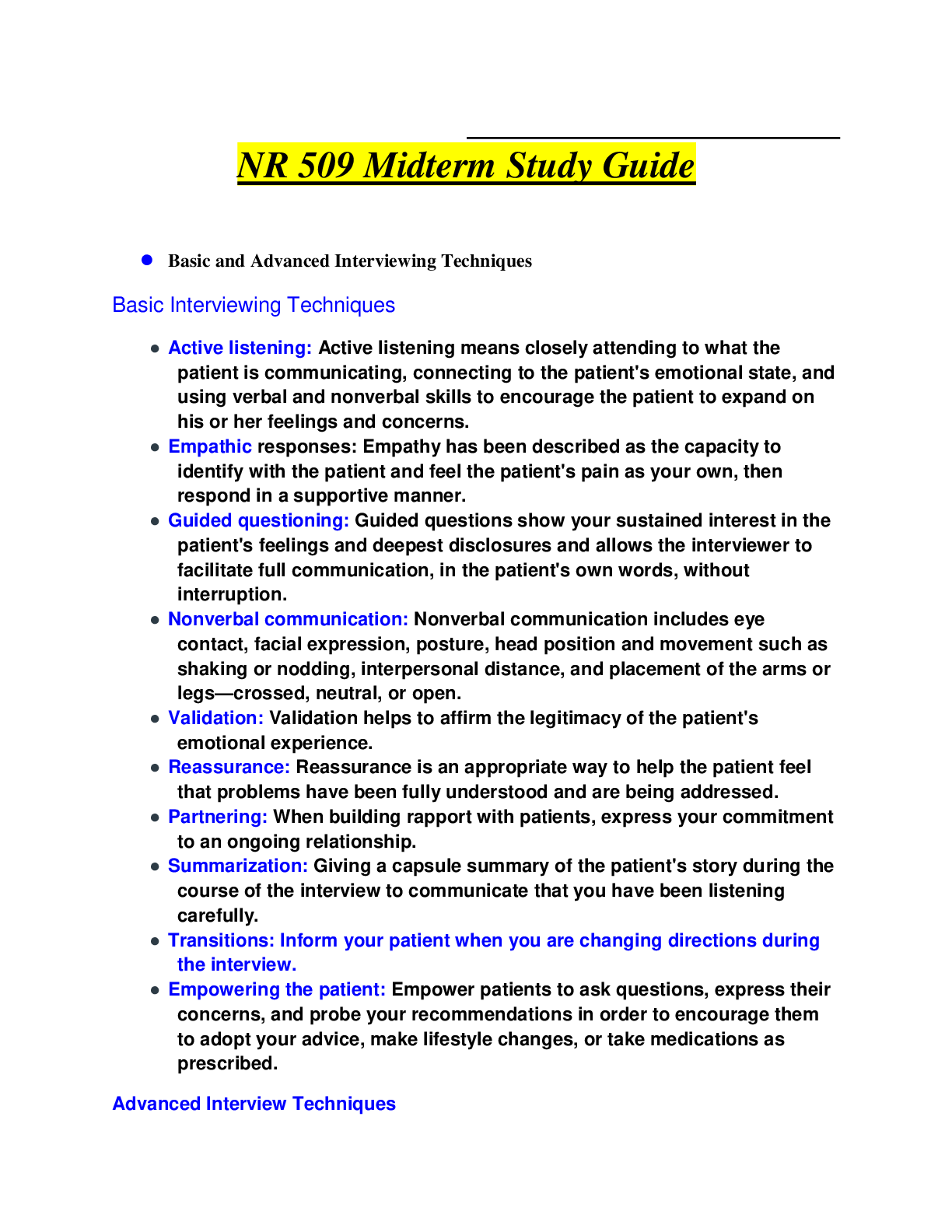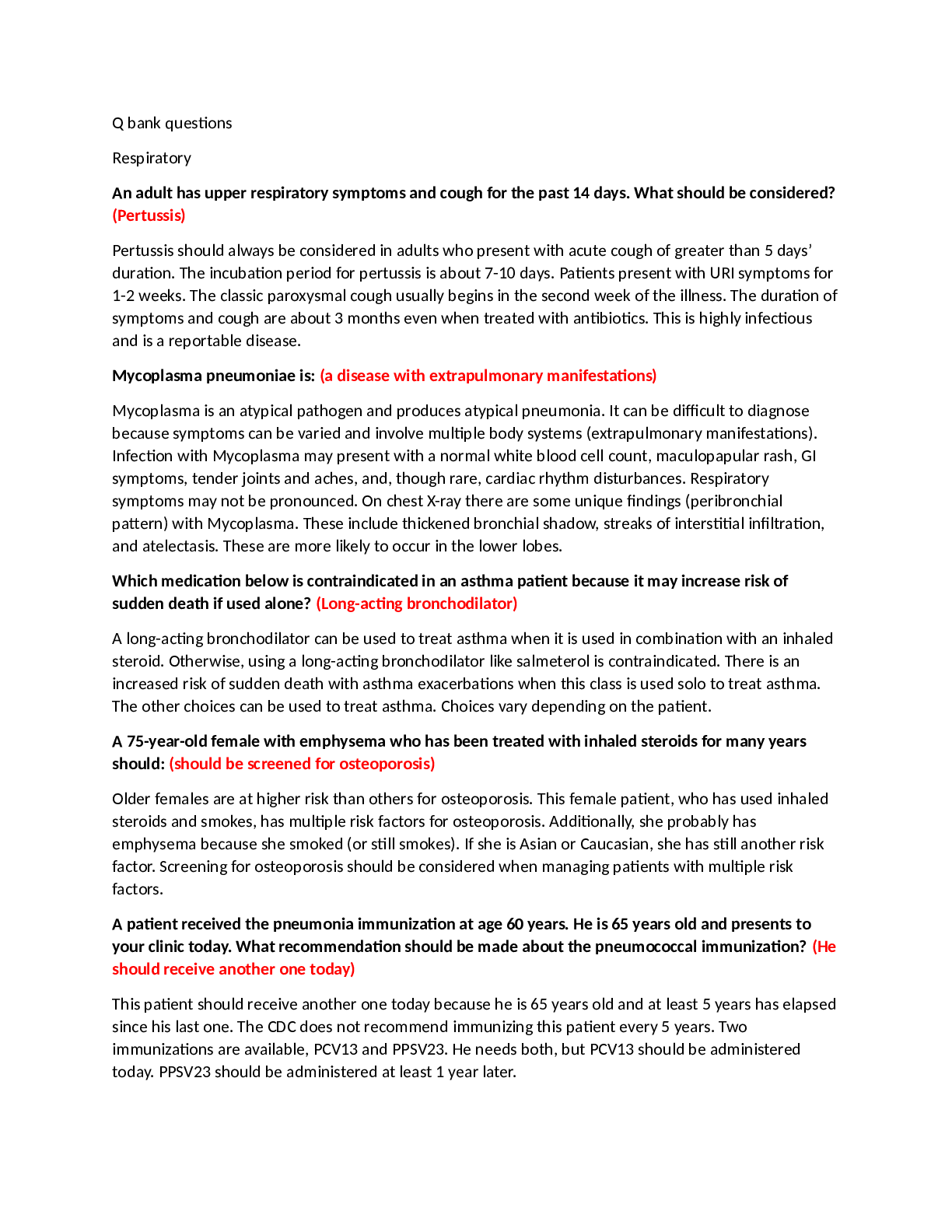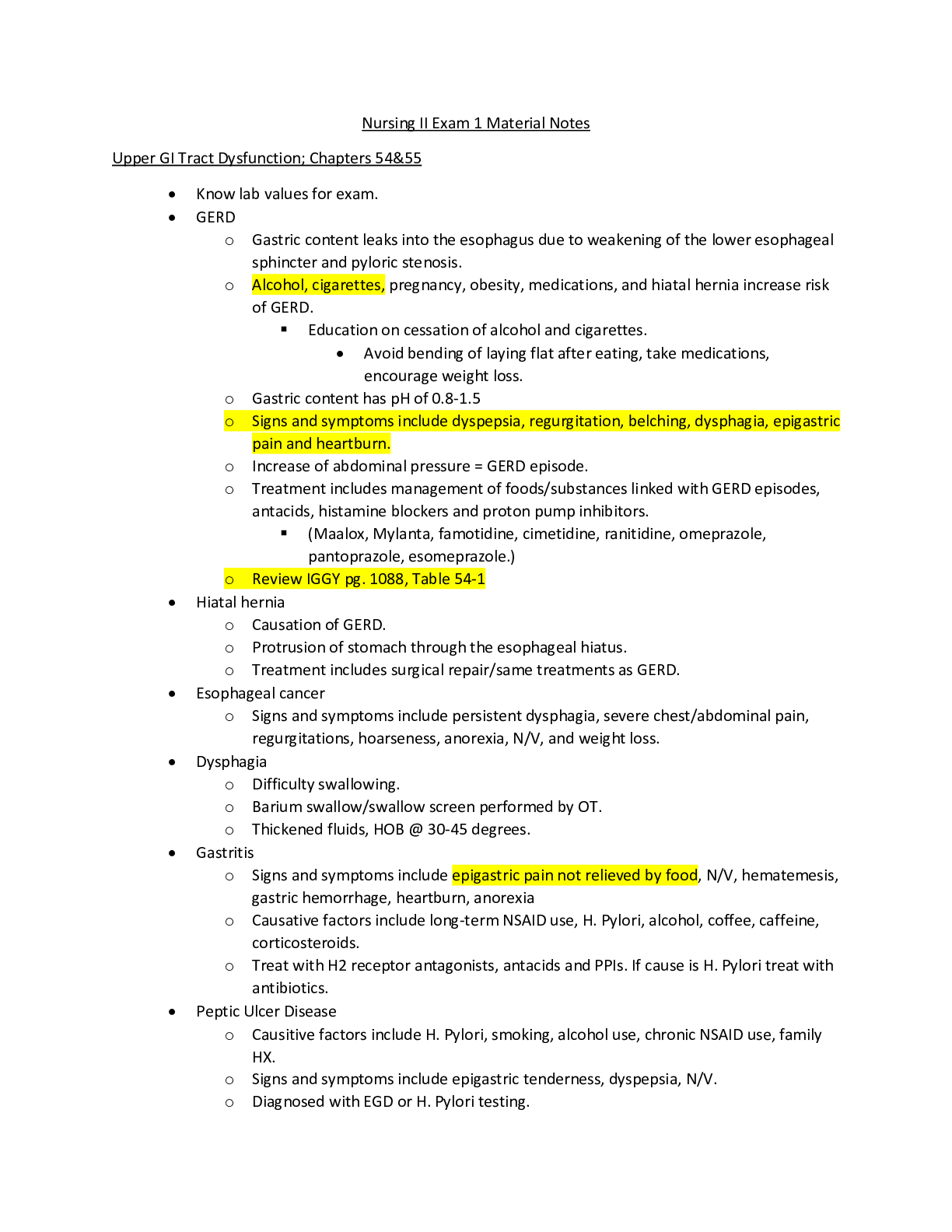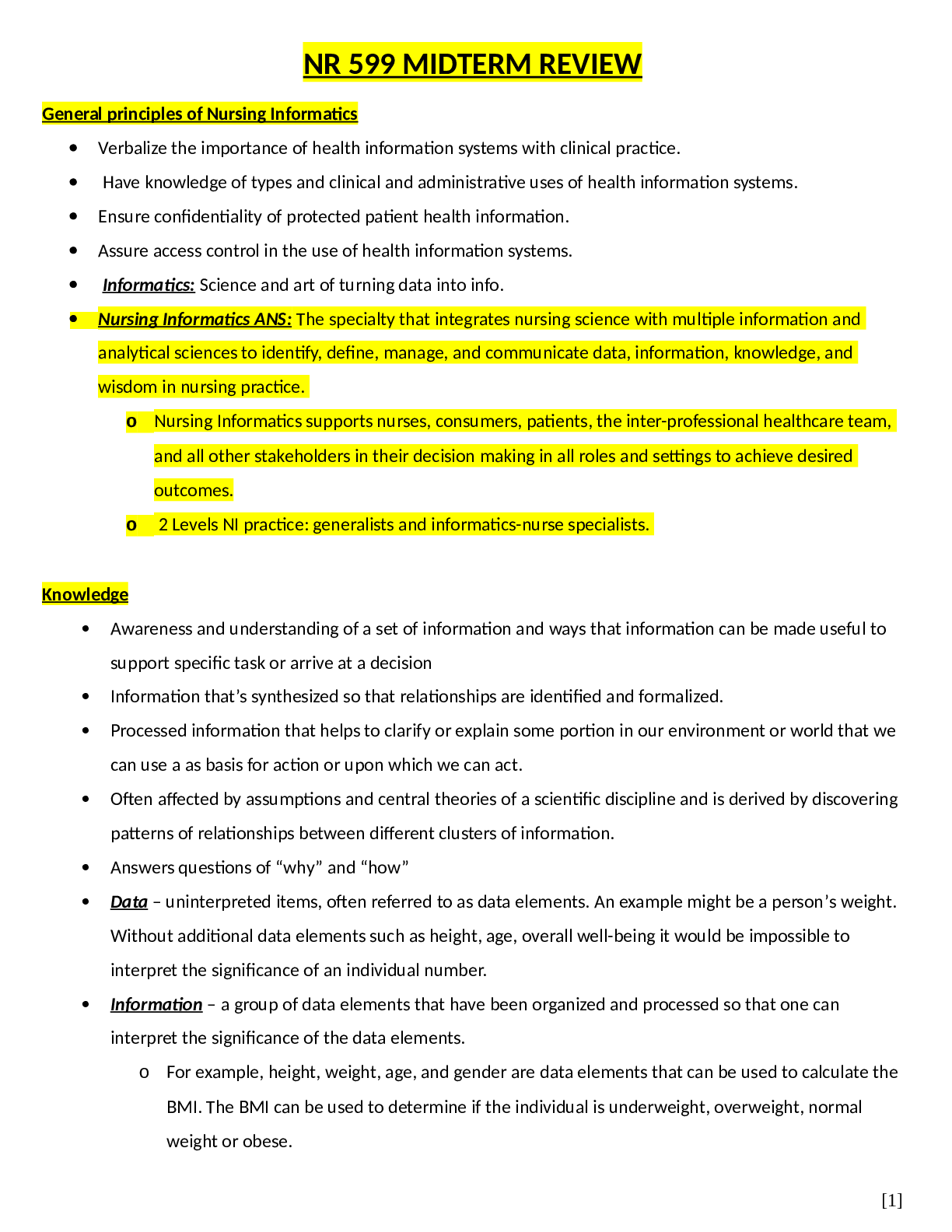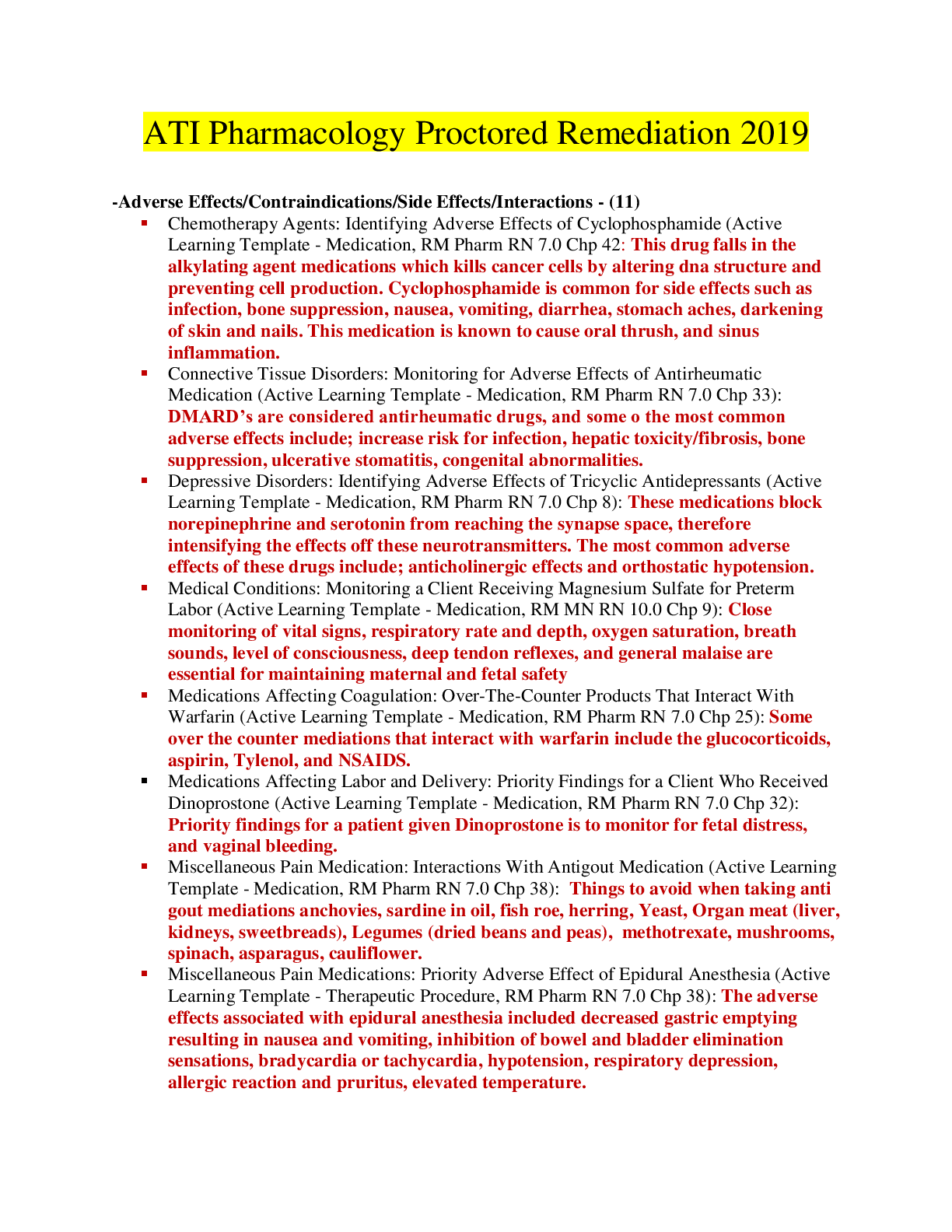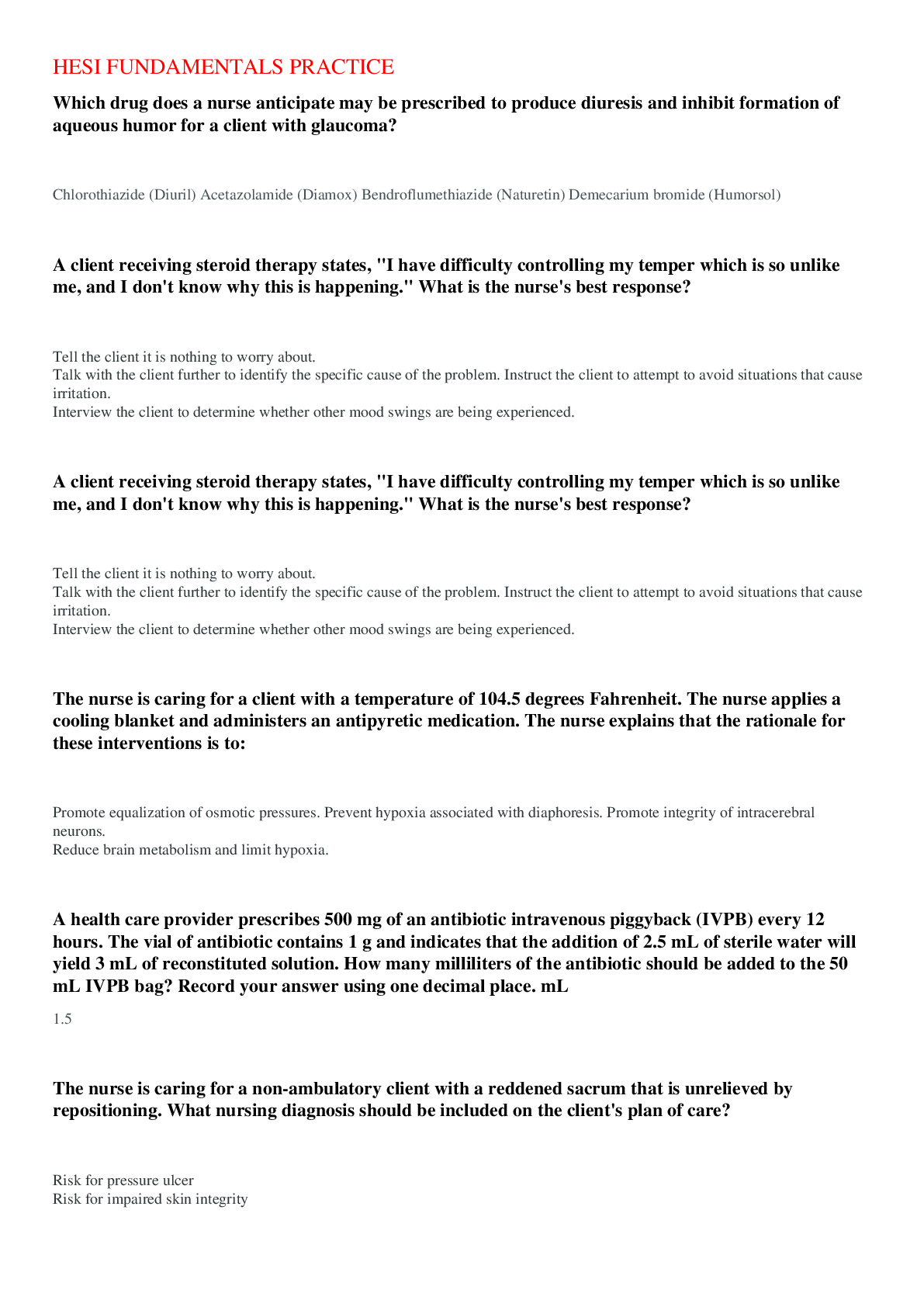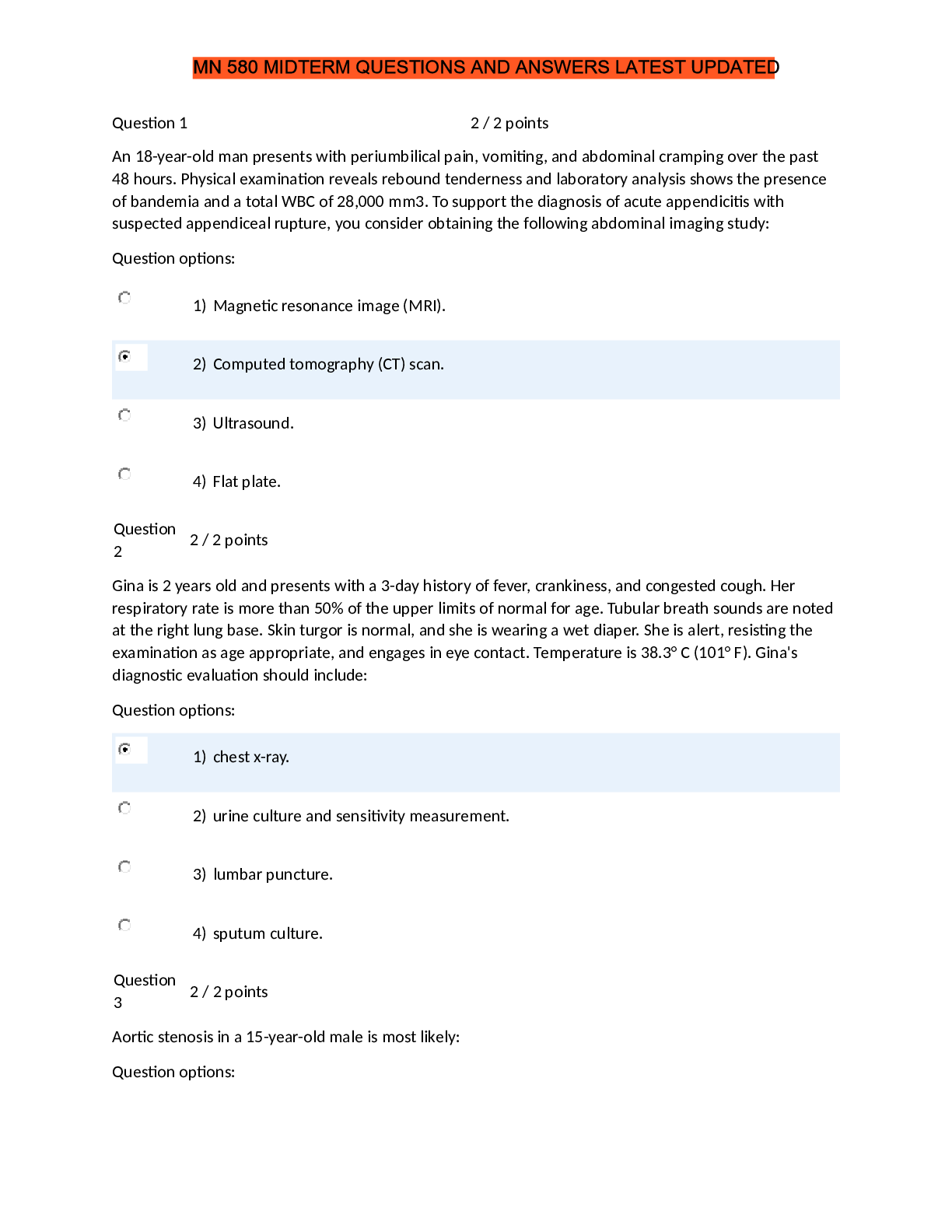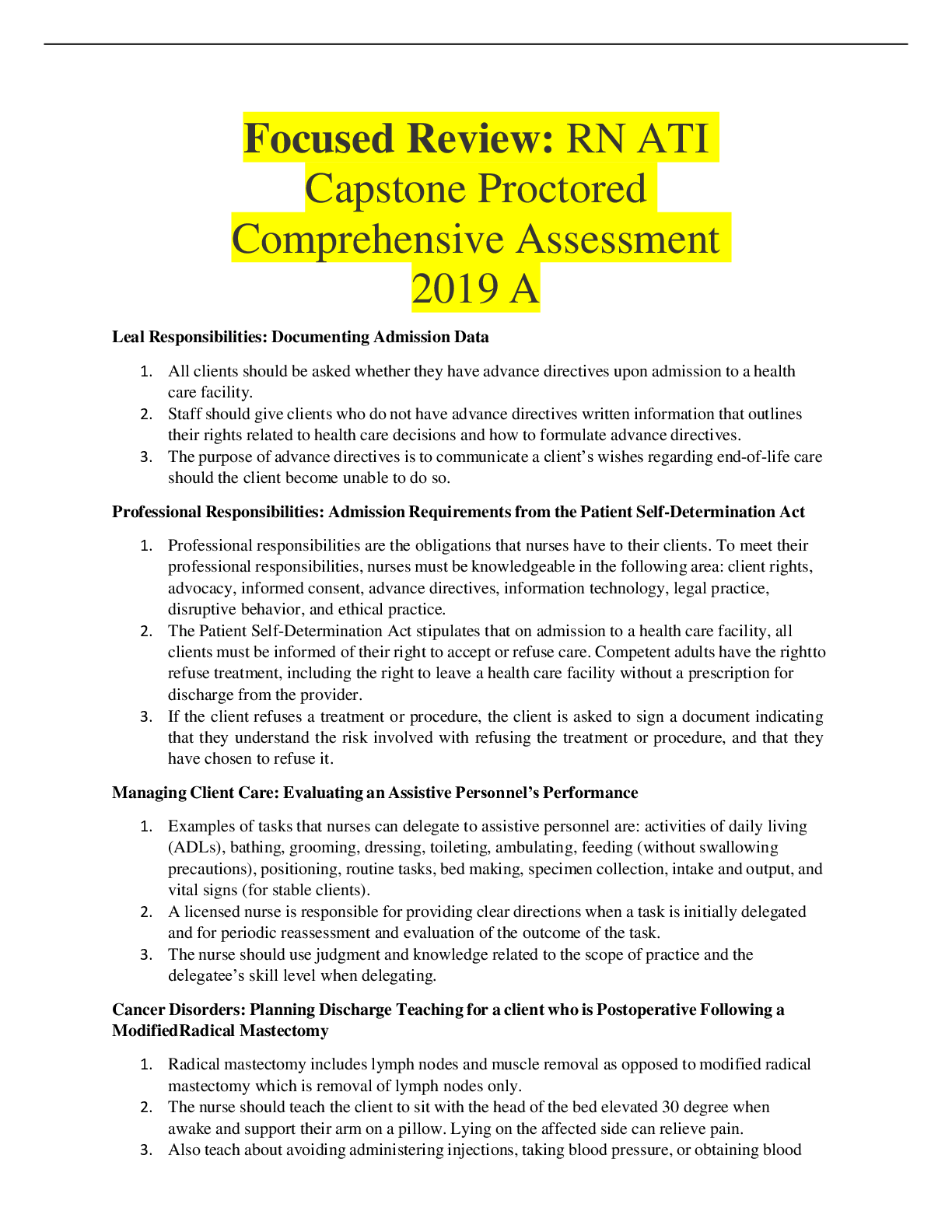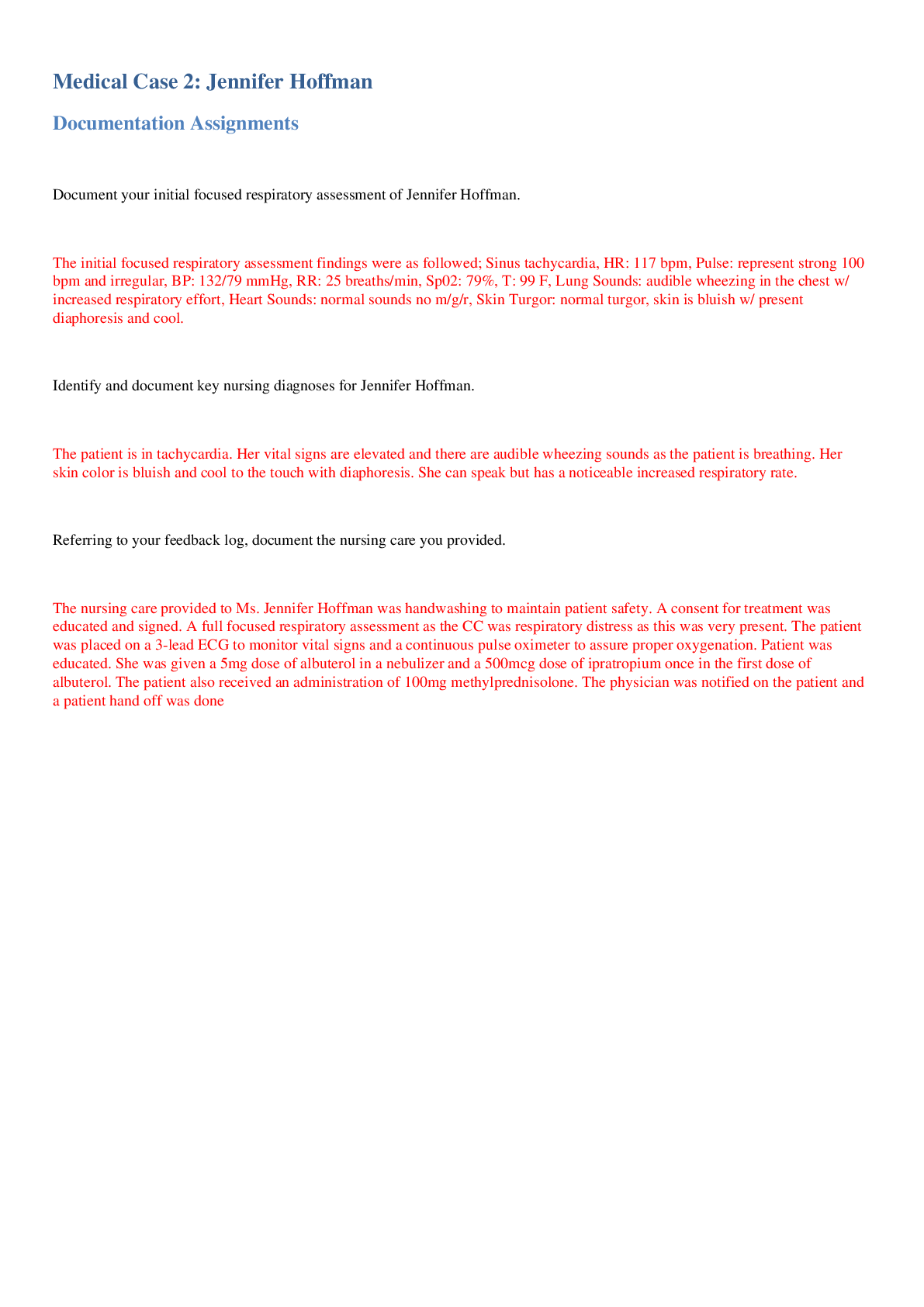*NURSING > STUDY GUIDE > Mark Klimek Lectures (CHAPTER 1-12) (All)
Mark Klimek Lectures (CHAPTER 1-12)
Document Content and Description Below
Lecture 1 • Mark Klimek • 92:21 Acid/Base Balance (Start times: 30:00) In order to solve acid-base disorders, it is important to know the normal values for pH, CO2 and HCO3 (bicarbonat... e), which are shown below pH 7.35 to 7.45 CO2 35 to 45 HCO3 22 to 26 The first value to look at in an acid-base disorder is the pH If pH is <7.35, the acid-base imbalance is acidotic If pH is <7.45, the acid-base imbalance is alkalotic Now, to determine if the imbalance is metabolic or respiratory, determine whether HCO3 goes in the same or opposite direction with pH Rule of the Bs: If pH and Bicarb move both in the same direction, then the acid-base imbalance is metabolic … Otherwise, it is respiratory Example #1 pH 7.3 Acidotic HCO3 20 Metabolic This is an example of metabolic acidosis Example #2 pH 7.58 Alkalotic HCO3 32 Metabolic This is an example of metabolic alkalosis Example #3 pH 7.22 Acidosis HCO3 35 Respiratory This is an example of respiratory acidosis As the pH goes, so goes my patient, except for Potassium … That means If pH is low, everything is low, except potassium If pH is high, everything is high, except potassium Page 3 of 92 If pH goes over 7.45, this is alkalosis Therefore everything is up: tachycardia, tachypnea, HTN, seizures, irritability, spastic, diarrhea, borborygmi (increase bowel sounds), hyperreflexia (3+, 4+) However, potassium is opposite. Therefore, hypokalemia What is the nursing intervention? o Pt need suctioning because of seizures If pH goes below 7.35, this is acidosis Therefore, everything is down: bradycardia, constipation, absent bowel sounds, flaccid, obtunded, lethargy, coma hyporeflexia (0, 1+), bradypnea, low BP However, potassium is high (hyperkalemia) What is the nursing intervention? o Pt needs to be ventilated with an Ambu bag—respiratory arrest So, remember that “MAC Kussmaul” is the only acid-base imbalance to cause Metabolic ACidosis with Kussmaul respirations Causes of Acid/Base imbalance First ask yourself, “Is it LUNG? … If yes, then it is respiratory Then ask yourself, “Are they overventilating or underventilating? o If UNDERventilating, then pick acidosis—pH is under 7.35 o If OVERventilating, then it is alkalosis, pH is over 7.45 What type of acid-base derangement is present in the following condition? In labor? o Respiratory alkalosis … Overventilating—pH increases … Alkalosis) Drowning? o Respiratory acidosis … Underventilating—pH decreases … Acidosis Pt is on PCA (patient-controlled anesthesia) pump? o Ventilation is down … Respiratory acidosis If it is not LUNG, then it is metabolic. If the patient has prolonged gastric vomiting or suction (sucking out acid), pick alkalosis For everything else that isn’t lung, pick metabolic acidosis So, when you don’t know what to pick, pick metabolic acidosis Tip Set your default setting to Metabolic Acidosis Always pay attention to modifying phrase rather than original noun Figure 1. Patient- controlled anesthesia (PCA) pump. Page 4 of 92 Ventilator A ventilator is a machine designed to move breathable air into and out of the lungs, aids patients who are physically unable to breathe, or breathing insufficiently to breathe … A ventilators is equipped with a high and a low-pressure alarm High pressures alarms are always triggered by increased resistance to air flow. Look for obstructions, i.e., Kinks in tubing … Solution: unkink the tube Condensed water in the dependent tube … Solution: empty it Mucus plugs … Solution: Ask pt to turn, cough, deep breathe; or suction the tubing PRN What is the appropriate order to address high pressure alarm in a mechanical ventilator? (1) Unkink. (2) Empty water out of tubing. (3) turn pt, ask pt to cough or deeply breathe, and (4) suction Low pressures alarms are always triggered by decrease in resistance. This can be caused by Main tubing disconnection O2 sensor tube disconnection In both cases, reconnect the disconnected tubing unless tube is on floor … Bag pt and call Respiratory Therapist The ventilator may be set too high or too low Setting is too high … Pt is overventilated o Respiratory Alkalosis … Panting Setting is too low … Pt is underventilated o Respiratory Acidosis … Pt is retaining CO2 Question The physician wants to wean pt off vent in the morning. At 6 am, the ABGs say respiratory acidosis. What would you do next? Notify the physician that the pt is not ready to be weaned off the respirator o Pt is is respiratory acidosis, which means that he is underventilated … Therefore not ready to be weaned off the ventilator o If pt were in respiratory alkalosis (overventilated), he should be ready to be weaned off Page 5 of 92 The title of this section is alcoholism. However, this rule can be used for any abuse situation 1. So, what it the number 1 psychological problem in child abuse? … In gambling? … In cocaine abuse? … In spousal abuse? … In elder abuse? a. The answer is denial Lecture 2 • Mark Klimek • 101:54 Alcoholism The #1 psychological problem is DENIAL How do you respond/treat to pts in denial? o Confront them by pointing out the difference b/w what they say and what they do o For instance, say something like: “Ok, you say you’re not an alcoholic but it is 10 a.m. and you’ve already had a 6 pack” … It is not the same as aggression. Don’t attack the person o Good answer has “I” … Bad answer has “YOU” o One place where denial is ok—loss and grief Stages of grief are “DABDA”—Denial, anger, bargaining, depression, acceptance o So when the question is about pt in denial, pay attention to whether you are dealing with loss or abusive situation Support = Loss Confront = Abuse Dependency vs. Co-dependency The #2 psychological problem is Dependency or Co-Dependency Dependency: when the get the significant other to do things or make decisions for them o The abuser is dependent Co-dependency: when the significant other derive self-esteem for doing things or making decisions for the abuser o The significant other is the co-dependent Dependency and co-dependency has a symbiotic, yet a pathological relationship o The dependent pt get a free ride on the co-dependent o The co-defendant pt feels good from “doing stuff” for the abuser How do you treat dependency/codependency? o Dependent pts are “abusers” … Confront them o Co-dependent pts have self-esteem issues … Teach pts how to set limits and enforce them o Agree in advance on what requests are allowed then enforce o Teach significant other to say no o Work on self-esteem on the co-dependent person Manipulation Manipulation is when the abuser gets the significant other to do things or make decisions that are not in the best interests of the significant other o The nature of the act is dangerous and harmful to the significant other Page 6 of 92 [Show More]
Last updated: 1 year ago
Preview 1 out of 92 pages
Instant download
Buy this document to get the full access instantly
Instant Download Access after purchase
Add to cartInstant download
Reviews( 0 )
Document information
Connected school, study & course
About the document
Uploaded On
Apr 09, 2021
Number of pages
92
Written in
Additional information
This document has been written for:
Uploaded
Apr 09, 2021
Downloads
0
Views
64

